By Bob Lowy
Returning to Europe and Searching
for My Family’s Roots:
Reflections of a Second-Generation Holocaust Survivor
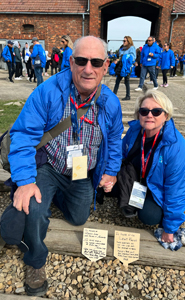
I was born and raised by two Holocaust survivors along with my maternal aunt and her husband. We lived in a consanguine home; we lived upstairs in a duplex home with my aunt and uncle living downstairs.
They had emigrated in the late 30s to escape the escalation of Jewish persecution. There was a tremendous amount of love in the home, but it gave “two sets of parents” a new meaning!
My mother, Edith, was one of the founding members of the speaker’s bureau of the Baltimore Jewish Council. She spoke freely and openly hoping to educate everyone and everyone and vowed to echo the mantra of all survivors to “never forget”! My father, on the other hand, internalized all that occurred and truly chose to speak privately and upon very rare occasions.
Twenty-two years ago, in the summer of 2001, Temple Oheb Shalom, created “A Journey of the Spirit” tour of Europe following the passage of the Jewish people in several central European countries. The trip began in Czechoslovakia, now called the Czech Republic. It kindled a flame and a desire within me to see, first-hand, where my parents began their separate journeys from their homes to the horrors of the camps, their survival, marriage and emigration and eventual arrival into the United States to start a new life.
In 2001 my mother was still alive and she advised me to begin my search for my father’s hometown of Tman; a small city about 45 minutes outside of Prague. My mother was born and raised in the Sudetenland and all that she knew and loved had been bombed and destroyed by the Germans and Allied forces.
Armed with a picture of the family farmhouse and pictures of the family grave site from the unveiling ceremony of my father’s sister, my wife, Maxine and I set forth on one free afternoon to embark on our search. Upon arriving at the town, we went directly to the City Hall and the Mayor’s office. Our guide, Ludmilla, asked if they knew of the Lowy family. The mayor shook his head and advised that no one had survived. Among tears, she told him that one had survived, and I was his son!
Upon realizing that I was a descendent of the original property owner, there was an immediate shuffle of cabinets and drawers! Initially, they showed me copies of the architectural plans of the farmhouse extension and my grandfather’s signature on the plans. It was all beginning to take hold and become a reality.
However, on the second set of paper copies was signature and proof of where our family had turned over all rights of the property to the city government; as if saying, don’t even think about filing a lawsuit to reclaim this property. Apparently, they had other descendants attempt to reclaim family property in the city and region.
I, on the other hand, was grateful to just stand on the family property, see the farmhouse, barn and pond and take a picture where my grandmother stood by the fence overlooking that pond. Land barons, they were not, but they had a good country life.
After we left the mayor’s office, we drove by a memorial built for all of the victims from the town who died in the war. Soldiers, as well as Jewish residents were engraved on the stone monument. It was most meaningful, as the day before we had seen my father’s brother, Rudolf’s name on the wall at the Pinkas synagogue in Prague. There, the names of all the victims of the Holocaust from Czechoslovakia were written on the wall.
I never knew my uncle and for that matter, never knew any of my four grandparents. They all died before the war. But, for the first time in my life, I could touch and feel the reality of my father’s family and my regret for never knowing any grands, uncles, aunts or cousins except for the one aunt and uncle with whom I had lived.
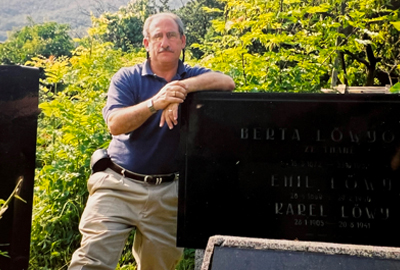
However, our search for the family grave site was unfulfilled and we were running out of time. Then Ludmilla remembered there was a Jewish cemetery not too far away in the next town over. Lo and behold, 15 minutes later we arrived in front of Chevra Kadisha Beroun. Not 50 feet from the entrance was the gravesite that I was holding the picture of in my hand.
The driver, our guide, Maxine and I, were all in tears! We had initially set out to say Kaddish for the family we never knew. We were so overcome with emotion that we were barely able to complete one of our most sacred prayers; but knew that no family member had said Kaddish for them in almost 50 years.
We were totally numb to stand in that space and truly for the first time in my life, I felt connected to a past that I had only been told of but always felt removed from it. My/our wonderful east coast Jewish life just has no relationship and bearing with the struggle and threat of life in the 30s and ultimate struggle to just survive the 1940s.
A day later, we visited Terezin concentration camp in the northern part of the Czech Republic. My father, who was single, and my mother and her first husband Paul, were deported there in October 1942 after being married for only five months!
At the central museum of Terezin, we first saw a movie. The opening scene shows the soccer games that occurred at the camp for the entertainment of the Germans, as well as the Red Cross inspectors who came to see that life in Terezin was a decent one! My father, who played soccer semi-professionally, was able to survive, playing on Sundays!
I was truly overwhelmed and again, for the first time, connected to what he had lived through. I knew firsthand from him that his survival was solely due to receiving more food, so that he could be healthy and strong enough to play soccer. He also played violin for the Red Cross inspectors in a concert gazebo on the grounds of Terezin; again, showing the normalized ghetto life.
My son has the water-color painting of that experience that my father had made stateside. A constant reminder for our family of a previous life. As we stood in Terezin and saw the barracks where my father lived and survived, working as a ghetto police officer, receiving a bit more food for his extra work, I was again connected to the stories and descriptions of my upbringing.
A few days later, our journey took us to Auschwitz & Birkenau concentration camps. I had a cell phone with me and was able to share with my mother as I walked the railroad tracks, barracks and memorial rooms as well as the gas chambers and crematoria. My mother had even described where the Terezin women’s barracks were almost concurrently with the guide!
My mother was enraged by the pictures she later saw of the grass covered areas. There was no grass in those times. People ate the grass as a source of nourishment. It was another reminder of the harshness and reality of concentration camp life.
Now, after two decades of having digested and shared those experiences with others, I decided to close the circle opened in 2001 and attend the International March of the Living in Poland and travel to Usti Nad Labem, a city in Sudetenland, to see where my mother was born and raised.
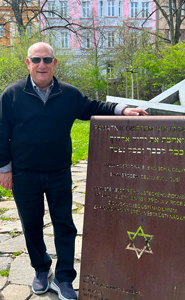
The trip north of Prague and Terezin camp was not as fruitful as my overwhelming find from my father’s town years ago. Although the town had been mostly rebuilt, I was able see the lovely countryside that she had described; the Elbe River running through the middle of the town and the rolling hills.
The Jewish cemetery had been desecrated and all that remained was a commemorative large Jewish star embedded into the park land. It paid homage to what had been there previously and a small metal carved display at the front walk declared its’ existence. Even the addresses that I had with me were of little value as the town and roadways had been so severely destroyed that they re-named many of the streets.
We were able to find the address of my grandfather’s textile business. It too was destroyed! I assume because it was identified as a Jewish business. The buildings on either side were intact to this day. I’m convinced the remaining rubble serves as a reminder to a thriving Jewish business that gave my mother and aunt “a spoiled life,” as she called it. While my mother had advised that we would find nothing there in the town, I found a sense of satisfaction in having been there.
The International March of the Living is an opportunity to join with over 10,000 adults and students from all over the world, in a symbolic march from Auschwitz 1 to Auschwitz 2/Birkenow; It is the largest Nazi concentration camp complex during World War II and the place that epitomizes the very abyss of humanity. As I walked in the footsteps of my parents, who were both in Auschwitz, I too remembered and honored them in their struggle to survive!
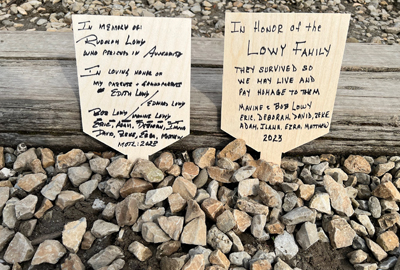
The balance of the trip was an intense investigation of Jewish life before the war, Hitler’s rise to power and how the solution to the Jewish question was brought to bear upon those that perished, suffered and survived. Whether in Krakow, Lodz or Warsaw; Auschwitz, Majdanek (Lublin) or Chelmo, the struggles and prevails of our people were constant reminders of how we, as a people, lived and survived. Not to mention the harshness and sacrifice of so many.
My parents always said they were incredibly lucky to have survived but mostly their strength of will, both mentally and physically, was the key elements to their survival.
My father was the only Lowy male of his family to survive. I was born in 1951, as an only child, but today, I can proudly say, that I have two sons and four grandsons to carry on the Lowy family name.
Although it is barely a month after my return and I’m still processing and coming to terms with all that I have seen and heard, I have a renewed sense of purpose to “bear witness” to anyone and everyone that I can.
I sincerely hope that others will make a personal commitment to honor the legacy of the survivors and be a defender of the Jewish people, to combat antisemitism whenever they see it and be the best ambassador to our community that one can be.
Bob Lowy
Chairperson of the Baltimore Jewish Council’s Holocaust Remembrance Commission.
Subscribe to our newsletter
The Associated is a home for everyone in the Baltimore Jewish community. We offer several email lists to help people find a community, engage with their peers and support Jewish journeys around the world.
Join Our Mailing ListAdd Impact to Your Inbox
Sign up for our newsletter
Subscribe to our newsletter
The Associated is a home for everyone in the Baltimore Jewish community. We offer several email lists to help people find a community, engage with their peers and support Jewish journeys around the world.
Join Our Mailing List

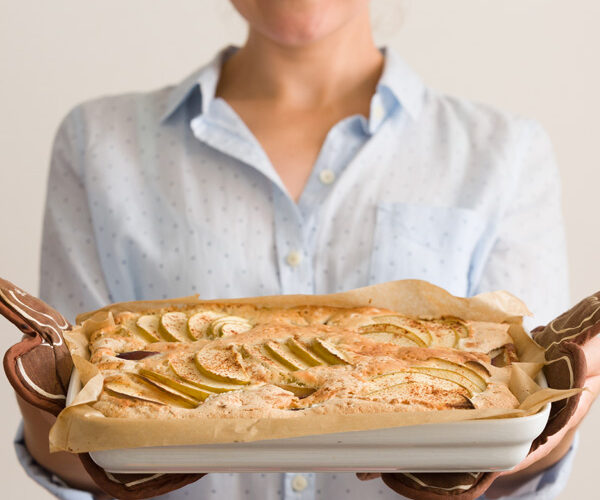
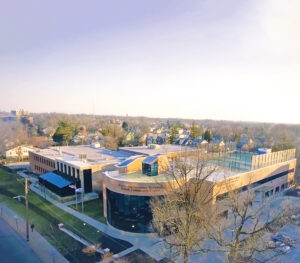
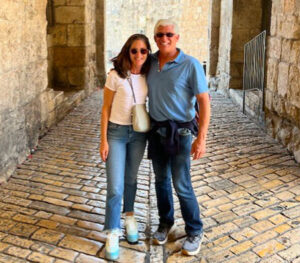
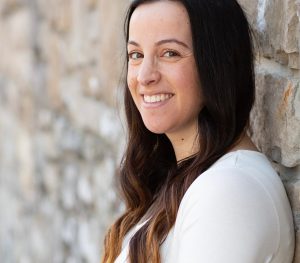
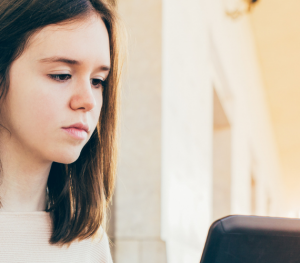

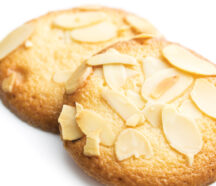
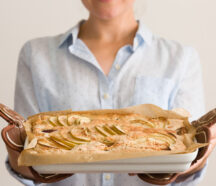
 Please Wait while we loading your video.
Please Wait while we loading your video.